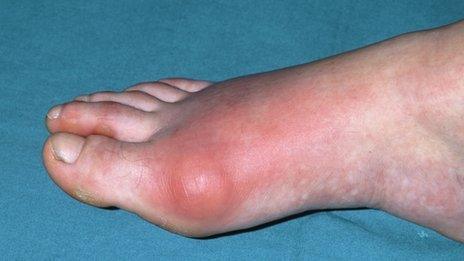Rates of gout in UK 'soaring'
- Published

The condition causes pain in the joints
The prevalence of gout - traditionally associated with too much port and an unhealthy lifestyle - is soaring in the UK, according to a study.
One in 40 people in the UK is affected, according to analysis of 15 years of results, in the Annals of the Rheumatic Diseases journal.
The disease, which particularly affects the overweight, can be countered by lifestyle changes.
But researchers say not enough people are getting access to medication.
Gout is a type of arthritis, caused by a build-up of uric acid in the blood.
Crystals of sodium urate produced by the body can form inside joints and can cause sudden and severe pain, together with swelling and redness.
Common among overweight
It usually affects the big toe but can develop in any joint.
And even though it was traditionally linked to "good living" among the wealthy, it can affect anyone.
However, it is more common in people who are overweight or obese and in those who have high blood pressure or diabetes.
Drinking too much beer or spirits can also increase the risk, but the condition can be managed through changes in lifestyle, like losing weight.
There is also medication available which lowers levels of uric acid.
In this study, researchers used the Clinical Practice Research Datalink (CPRD) to look at the number of existing and new cases of gout in the UK between 1997 and 2012.
Among more than 4.5 million eligible people on the database in 2012, almost 116,000 already had gout. More than 7,000 new diagnoses were identified.
Between 1997 and 2012, the prevalence of gout rose by 64%, increasing by around 4% every year.
Rates were around four times higher in men than women across the entire period, and the highest rates were in Wales and north-east England.
Researchers from City Hospital in Nottingham, who carried out the study, said access to effective medication remained a problem.
In 2012, fewer than one in five patients was prescribed medication within six months of their diagnosis, and only around one in four was on this treatment a year after diagnosis.
Gout 'most painful'
The UK Gout Society said: "The increase in gout is a result of a combination of factors - primarily an ageing population and a growing obesity problem in the UK.
"People who suspect they have gout should seek help from their GP as the first port of call who will then refer them to a rheumatologist should they continue to suffer from repeated gout attacks."
Prof Alan Silman, the medical director of Arthritis Research UK, echoed the concern about obesity and identified foods such as red meat, shell fish and dairy, and red wine and beer as potential contributors.
He said: "A severe attack of gout is probably the most painful form of severe arthritis there is - worse than rheumatoid arthritis or osteoarthritis.
"It is not a trivial condition, yet its reputation as a 'joke' disease that only affects florid-faced country squires has meant that over the years it's not always taken as seriously as it should be.
"People can reduce their chances of getting gout by changing their lifestyle."
- Published28 September 2012